Frankston Bypass
LMA (was SEITA) Bulldozers trash bushland from Westerfield to the Pines
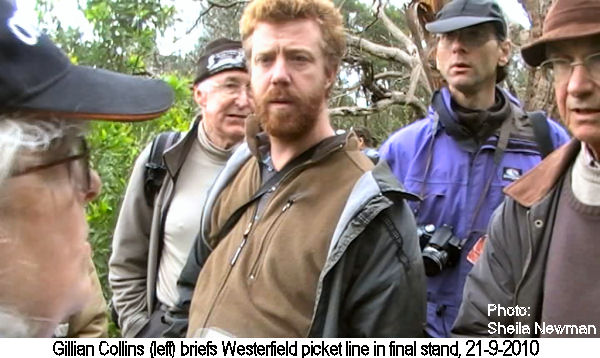
 This is the sequel to our important, long-running article,"SEITA Bulldozers imminent on Westerfield Bushland Sth Frankston - Picket-line plans up to Victorian Elections" (was "SEITA Bulldozers threaten...". Update, Monday 27 September 2010: VCAT Appeal and Be ready on site for action Tuesday 28 Sep
This is the sequel to our important, long-running article,"SEITA Bulldozers imminent on Westerfield Bushland Sth Frankston - Picket-line plans up to Victorian Elections" (was "SEITA Bulldozers threaten...". Update, Monday 27 September 2010: VCAT Appeal and Be ready on site for action Tuesday 28 Sep
On 21 September 2010, Gillian Collins, who has led the defense of the Pines Bushland and wildlife corridors, against the Frankston Freeway for years now, may have taken her final physical stand on this on the battlefield at Westerfield, where she has been manning a picket-line since Monday 5 July 2010. I doubt, however, that we have heard Gillian's last word on this matter, because as she went down, she was brandishing papers and talking barristers.

[Clarification: Linking Melbourne Authority is the new organisation or name which has replaced SEITA in this section of the Freeway. It's hard to keep up with these name changes.]
Update, Monday 27 September 2010: VCAT Appeal and Be ready on site for action Tuesday 28 Sep
Here is news from the front concerning the threatened destruction of historic Westerfield with construction of Peninsula Link (Frankston Bypass). As reported earlier. on Thursday 23 September 2010 Roads Minister Tim Pallas gave an undertaking that work would be suspended until after a VCAT appeal had been heard.
The AbiGroup and its sub-contractors are apparently not working on the property today, Monday, because they have an agreement with CFMEU to honor their "lock down" week-end.
Gillian Collins says that if the AbiGroup and Linking Melbourne authority do not comply with Minister Pallas' decision to suspend the work until the VCAT appeal has been heard, then we will need to show up in force at Westerfield on Tuesday - tomorrow - to continue to make our case.
So the message is - prepare to come to Westerfield tomorrow early if possible. Check later today on www.savethepines.net. This will have current information. Gillian suggests that if there is to be a picket tomorrow coming to the Westerfield house parking lot and then walking down to the picket line. Hundreds of people have visited the picket over the past months. The community support is very much appreciated.
Contact: Gillian Collins, Pines Protectors Phone: 03-9782-5116 Mobile: 0414 309 960
Source: Julianne Bell, Protectors of Public Land
From Gillian: Update#1, 0815hrs, 23-9-2010
Police informed Gillian and site manager confirmed that no trees will be cut down today. Site fences will be built.
From Gillian: Update #2, 22-9-2010
It was a long day today - but what a day! About 60 protestors came to our community picket today and stopped the bulldozers. We owe you such a great debt of gratitude. As Shakespeare's Richard V said in a very loose modern translation - you should have been there!
I am in awe of the courage shown by our faithful band, and by the exceptional work and support shown by the two CFMEU organisers who came to help. Thanks to them and some great mediation by the Frankston Police, we have a short reprieve until 7:00am Thursday morning. Between now and then the Pines Protectors under the auspices of the Frankston North Community Group, Inc. will be filing a case with VCAT to stop the contractor until offsets required by the Native Vegetation Framework are secured. We will also continue to work with the CFMEU and the contractor to get more time.
If we can't stop the contractor from continuing, the bush will be destroyed on Thursday. We saw enough raw power in their three PC300 excavators and a bulldozer today to destroy Westerfield's in a day - a terrifying thought. Some of us will still be there trying to stop them on Thursday. We would welcome your companionship and participation as we face this real life terror.
Gillian Collins
Pines Protectors
0414 309 960
Update 22-9-2010
"Protest co-ordinator Gillian Collins said the group would go to the planning tribunal today to see if there were legal avenues to stop demolition. If the group is successful, the case could become the first test of state legislation put in place last year to stop last-minute legal objections delaying big transport projects. Ms Collins said police had informed the protesters they would be arrested on Thursday morning if they remained. Abigroup spokeswoman Carol Bartley said yesterday work had been put on hold until Thursday morning."
Source:Clay Lucas, "Protesters fight to delay Frankston Bypass work," The Age, September 22, 2010.
The Front Line
Gillian Collins, who has led the defense of the Pines Bushland and wildlife corridors, against the Frankston Freeway for years now, may have taken her final physical stand on this today, September 21, 2010, at Westerfield, where she has been manning a picket-line since Monday 5 July 2010F. The freeway is the work of SEITA and the Victorian Government, and this encounter was with Abbey Road Construction. I doubt, however, that we have heard Gillian's last word on this matter, because as she went down, she was brandishing papers and talking barristers.
Negotiations
Good for her!
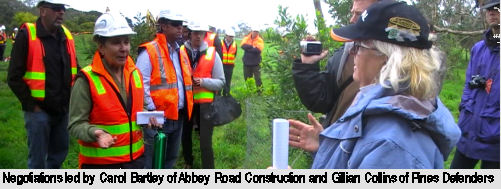
She continued to negotiate firmly right to the end with an Abbey Road Construction team, on behalf of the picketers, and all remained on site, to block the passage of the bulldozers in order to defend the wildlife and the trees.
As the picketers stood their ground against several bulldozers, whilst awaiting the arrival of the police, other construction workers began to chainsaw trees at the other end of the property, where the picket-line had its marquee.
Ceci Cairns painting one final beautiful record of tragically destroyed beauty
(My apologies at not getting a picture of the painting which could be reproduced on its own. It is a lovely painting and should become valuable as a unique aesthetic record as well.)
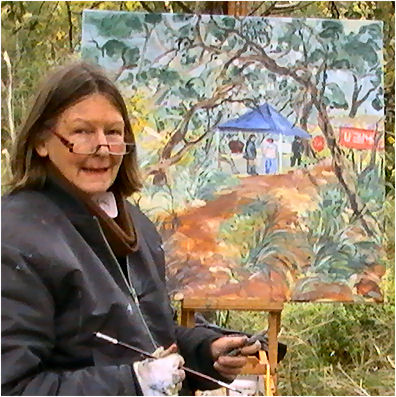
An artist working there, Ceci Cairnes, who had been painting the trees and the tent, was alarmed to see the chainsaws arrive. "No-one even spoke to me. Not even to tell me to be careful. They just began sawing down trees."
When I left only a few trees had been sawed down, here and there, as though the moonscapers didn't want their work to look too obvious right away. Perhaps they intended to finish it at night. A woman carrying one small animal cage - the kind you take a cat to the vet in, followed behind a small group of construction workers, which proceeded towards a large, beautiful dam, surrounded by luxuriant vegetation. As they disappeared among the foliage, I heard their chainsaws start up.
War-zone

My dog had been waiting for me in the car for a couple of hours, so I was anxious to take him walking. I consoled myself with the idea that there were still some areas between here and the Pines Reserve where we could walk off-leash for a kilometer or two without putting wildlife in danger. Heading for the area between Skye Road and the Pines, that runs parallel with McClelland Drive, I passed scenes of complete devastation. Next door to and opposite Peninsular Private Hospital, on the corner of McClelland and Cranbourne Road were moonscaped, with not a tree standing, but mounds of massacred vegetation with broken trunks and branches poking out, and hills of bare, drying earth. You could almost hear the silent screams - or perhaps they were my own - as the earth and the creatures in it died and released the carbon they had stored in their living bodies.
There was industrial mowing along McClelland Drive. Bulldozer-like machines with long metal arms with lawnmowers on the end mowed the roadside vegetation on the left as they drove down the road. This was the first time I had seen such machines. I marvelled at their number, at the embodied energy in these monsters, and at the trouble engineers take to remove every last scrap of life from their projects.
No-where to walk left
When I got to Skye Road, I reeled in horror, because the bushland on both sides was also now reduced to mute and damaged carcasses, bulldozed up to form a dark wall on the horizon. I saw that the actual tree-lined-track beside walled new suburbs that I usually took from Skye Road to the Pines had been spared, although everything between it and McClelland Drive had been blasted. Determined to console myself with this last remaining bit of green, I drove the car up to it and parked. My dog got out of the car eagerly, looking forward to running finally.
All part of "the plan"?
Alas, our way was barred. A grotesquely cheery blue sign announced on behalf of the Victorian Government that this was "all part of the plan!" Maybe body-snatchers have invaded our leaders in Victoria. That would explain their alien plans for the rest of us.
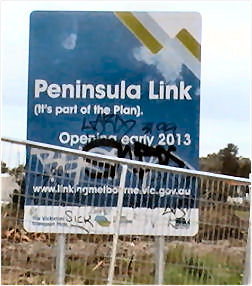
Infuriated, I drove on to a road that leads to the golf course on McClelland Drive. Word was that they had done a deal with SEITA to have their course saved when parts of the adjacent Pines Wildlife reserve had been sacrificed. I thought that I should be able to get into the reserve with my dog, via the golf-course. I realised I would have to keep my dog on a leash, but it would be better than nothing.
Locust-like swathe cuts Pines Reserve
The entrance gates to the Pines Reserve adjacent to the golf course were covered in signs telling the public to keep out, but the gates were wide open, and Nubi and I had had enough. We walked through the gates, heading for the sand-hills in the distance. Alas, to the left and to the right were more scenes of devastation. The bulldozers had already been through here too, leaving only a few self-important little men in florescent parkas walking about with mobile phones a few hundred meters away.
Log-truck load in Frankston Pines
My gaze was arrested by a truck bed stacked with enormous logs. I had not thought that there were such large trees left in this area. For a moment I thought this must be part of an exhibit I had seen in the outdoor exhibition at the McClelland Gallery, but these logs were much larger. I wondered what would happen to them.
At last I realised the extent of the Frankston Freeway: it was going to trash most of the bushland I had come to love in the 20 years since I moved into an old house here - no, not some new development. Below is my google-earth grab of what it looks like to me.
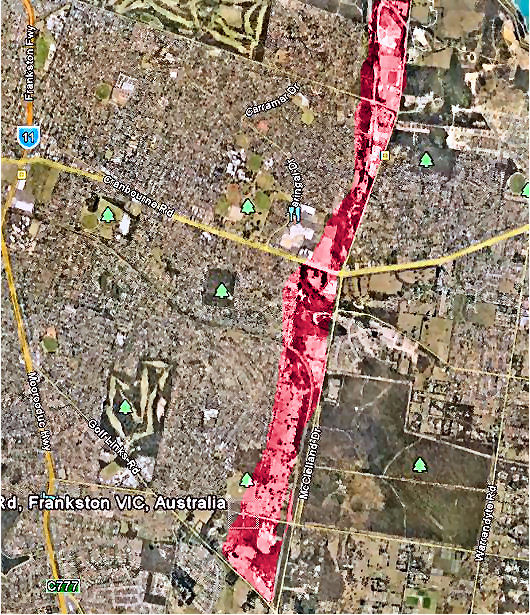
The Victorian Government is at War with Nature
The Victorian Government is at war with nature and the people who defend nature. It has been shown to flout its own laws on fauna protection. It presses the interest of property developers and passes laws to promote property development in the name of economic growth which it prioritises over all other things. It forces population growth on the people of Victoria and thus creates new pressures daily for our natural environment. We are not able to affect our government democratically on these issues because the opposition holds similar values to the government. The Victorian Greens won't criticise population growth or property development as priorities, only trying to minimise a harm which must eventually overwhelm all attempts to compensate for it or otherwise attenuate the damages it causes to our natural surroundings and the fauna which depend on them.
The Victorian government licenses agents, such as Abbey Road Constructions, to carry out its will and expects the police to back up such corporate activities in the field. It thereby forcibly exerts its will against democratic objection.
How should Citizens react to forcibly carried out undemocratic actions which they hate?
Most of us cannot afford to access the formal legal system and there are few laws to defend the environment and fauna and flora which the public can actually make a complaint under. Usually those laws require another party - often a State Government agent or an NGO in receipt of government funding - to act on behalf of the public and bring a complaint, and this so rarely happens.
In the absence of legal resources, for whatever reason - either by lack of money or lack of good laws, how should citizens react to force? They cannot afford to initiate force because the state holds the power and the means of savage repression. Citizens do, however, have the moral right to resist the state or its agents and contractors where they forcibly act against democratic objection and the spirit of laws to defend environmental and ecological values, for all kinds of reasons.
The importance of picket lines
The use of picket-lines represents a reasonable and defensible response where citizens use their bodies to resist the impacts of unreasonable government policies, whether carried out by a contractor or directly by government employees, in the opinion of this author.
Gillian Collins and others on the Westerfield Picket line took a courageous and necessary step in the battle of Victorians to defend their right to protect and conserve their natural surroundings and the right of indigenous fauna to live in peace. They have not won this battle, but the war is still on and there must be more battles.
Community Concerns over Minister Gate-Crashing Inquiry (Melbourne Parliament)
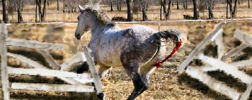 When the Standing Committee on Finance and Public Administration hearing convened to hear from Peta Duke on 12 March 2010, she did not attend in answer to the summons. She had written the notorious Media Plan proposing a sham public consultation process to earn favour with the electorate. Mr Madden, who had not been summoned, sat in the chair reserved for the witness – his former Ministerial adviser - and said that he would answer questions. This was a blatant attempt to take over the inquiry being carried out by Parliament into his office’s conduct. - Protectors of Public Lands (Victoria)
When the Standing Committee on Finance and Public Administration hearing convened to hear from Peta Duke on 12 March 2010, she did not attend in answer to the summons. She had written the notorious Media Plan proposing a sham public consultation process to earn favour with the electorate. Mr Madden, who had not been summoned, sat in the chair reserved for the witness – his former Ministerial adviser - and said that he would answer questions. This was a blatant attempt to take over the inquiry being carried out by Parliament into his office’s conduct. - Protectors of Public Lands (Victoria)
When the Standing Committee on Finance and Public Administration hearing convened to hear from Peta Duke on 12 March 2010, she did not attend in answer to the summons. She had written the notorious Media Plan proposing a sham public consultation process to earn favour with the electorate. Mr Madden, who had not been summoned, sat in the chair reserved for the witness – his former Ministerial adviser - and said that he would answer questions. This was a blatant attempt to take over the inquiry being carried out by Parliament into his office’s conduct.
By his crass tactics in derailing the hearing of a properly constituted committee, the Minister of Planning has tried to frustrate the accountability to Parliament of himself and his office. The Premier and the Attorney-General have supported this tactic.
"Grave abuse of power"
This impropriety strikes at the heart of Parliamentary democracy and is a grave abuse of power.
Julianne Bell, Secretary of Protectors of Public Land, Victoria, (PPL Vic), attended the hearing. She commented:
“The Minister had the opportunity to explain himself during the nine hours of debate on the subject the previous Wednesday but chose not to attend. Why would he expect a hearing now?
Minister failed to use legitimate opportunities to explain himself
Over the last six months PPL has made extensive submissions to both the Planning Department and Heritage Victoria on proposed policy, and on planning decisions, including:
• the Review of VCAT (Victorian Civil and Administrative Tribunal),
• the extension of the Urban Growth Boundary,
• the Mornington Peninsula Link (through Westerfolds);
• the Melbourne International Flower and Garden Show in the Carlton Gardens; and
• the Windsor Hotel development.
Any suggestion that public consultation could be treated as a sham is of grave concern to PPL disclosing as it does a cynical attitude to the people of Victoria. The actions of the Minister have now treated the Parliament, to which he is accountable, and which represents the people of Victoria, with contempt. The community expects our democracy to be respected.”
"Scandalous situation made worse"
Brian Walters SC, President of PPL Vic, said:
“Minister Madden has made a scandalous situation far worse. As found by the Children Overboard inquiry in the Senate, ministerial advisers have no immunity from appearing before parliamentary committees, yet it seems the Government has attempted to direct or advise her to disobey the summons to do so. This undermines the rule of law and Parliamentary oversight. If the Minister’s office is not accountable to Parliament, we have lost one of the most fundamental checks of our democratic system.”
Source: Press Release from PPL (Vic), 14 March 2010
SEITA tollway using old data on oil prices
by Sheila Newman and Richard Laverack
Why build more roads now?
Why on earth, with petroleum supplies not meeting demand and oil prices through the roof, are we still engaging in public-private partnerships with road builders???
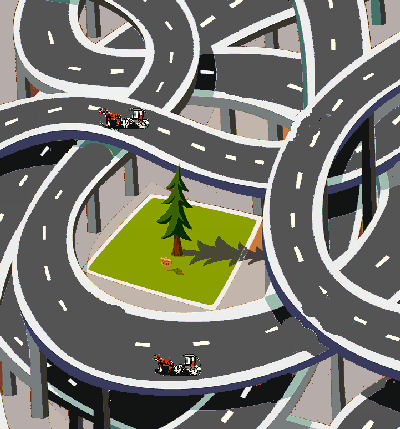
Australia is currently set to be criss-crossed by new roads, tunnels and tollways. A case in point, which we have studied is the SEITA Eastlink tollway, which is being built by ConnectEast in a private-public partnership with the Victorian Government.
So, why is Victoria engaged in massive road construction just now? And, why are we persisting with Eastlink, all the way down the Mornington Peninsular when we could simply stop it now?
We found some strange answers to our question towards the end of a SEITA document called, "Frankston Bypass Environment Effects Statement, Strategic Transport Modelling Technical, dated 3rd March 2008, in "Clause 5.7 - Impacts of Fuel Price Changes."
"The MITM adopts current estimates of vehicle operating costs (fuel maintenance etc) on a per kilometre basis in order to assist in determining route choice behaviour. However, these estimates remain constant for forecast years (2011, 2021 and 2031) since vehicle operating costs are unknown. However, it is worth investigating the elasticity of traffic demand with respect to fuel price in order to gain insight into the effects on traffic demand if fuel prices were to change in the future.
"Table 17 shows both short and long run elasticities of demand for fuel consumption and Vehicle Kilometres Travelled (VKT) with respect to fuel price. In the long term, and elasticity value of - 0.29 for VKT with respect to fuel price would mean that a 10% increase in fuel price would result in a 2.9% decrease in VKT. However, in reality motorists adjust much more to fuel price rises in relation to fuel consumption, either through more fuel efficient vehicles or better driving techniques to conserve fuel. This situation is likely to be even more relevant for the Frankston Mornington region where limited alternative transport options exist.”
SEITA then lists its source as Goodwin Dargay and Hanley (2003), referring to "Elasticities of Road Traffic and Fuel Consumption with respect to Price and Income: a review," ESRC Transport Studies Unit, University College London.
Let's analyse those statements.
Note that, In 2002, when the 'research' into trends for that review would have been done, oil was $22 a barrel. 10% of $22 is $2.20.
If all we had to cope with now was a $2.20 increase on $22, a freeway might still make some kind of sense. Now, however, only 6 years later, oil is over $140 a barrel. This is about 6 times the 2002 price of oil and represents a rise of 536% !
What has happened here? Well, we cannot say for sure, but what usually happens is that projections are based on past trends, and, since from 1987 to 2002 prices did vary more or less only by about 10%, to assume they would go on doing so would be to base one’s projections on past trends.
But those were not the only trends in the past.
Between 1973 and 1987 prices rocketed, but SEITA and the Victorian Government are proceeding as if the 1987 to 2002 trends will last for at least another half century.
The reality is that, since 2003, prices have increased continually, and have gone well beyond any previous levels in 2008, with little sign of ever coming down to the kind of trends relied upon by the Victorian government and ConnectEast to make the tollway a profitable, worthwhile or sensible transport option.
Have a look at trends in oil prices in the graph below:
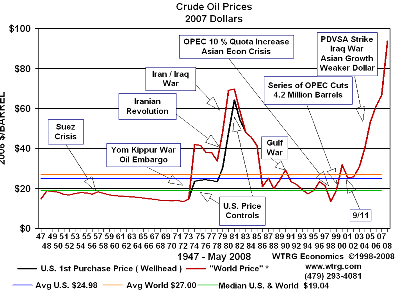
(Source is "Oil Price History and Analysis," WTRG Economics' Energy Economist Newsletter, http://www.wtrg.com/prices.htm. Prices are in 2006 dollars.)
Now why would an engineering company like ConnectEast, in the business of making roads, be unaware of the rising oil prices? Oil prices severely impact on the cost of the construction materials and the fuel used by roadmaking vehicles. Building Eastlink must be costing more every day. "Well in excess of 90% of the total construction budget has been spent," already in February 2008, according to The Age, in Simon Mann, "Long and winding road nearly ready to roll", February 16, 2008.
It would be strange if all ConnectEast's engineers and other staff, and SEITA's government advisors, were not aware of oil production curves and theory.
What of the Victorian Government - ConnectEast's partner - in tollroad ventures?
The government has received submissions and press releases from various groups about petroleum depletion projections and oil prices and there has been a Senate enquiry into oil depletion.
The Australian CSIRO study by Barney Foran and Franci Poldan, Future Dilemmas: Options to 2050 for Australia's population, technology, resources and environment, published in 2002, was already flagging problematic trends. See Chapter 4, "Natural Resources and the Environment".
The VAMPIRE study from Griffith University, Queensland, drew attention to Melbourne for its oil-reliant transport vulnerability.
Apart from that, explosive oil prices and depletion fears are constantly in the news. One would therefore be entitled to expect the Victorian government by now to be aware that business as usual has gone completely off the radar.
One has only to go to Amazon com to find a hundred or so books written in the last ten years about the coming energy and fuel crisis, most restating and reaffirming projections made for peak oil production and then decline to start around about now.
If that were not enough, in the past few days, on July 11, 2008, the CSIRO came out again and warned that the cost of petrol could rise to $8 a litre in the next 10 years.
Yet SEITA and the Government still seem to be basing their traffic projections for the next 30 years on a series of totally obsolete oil price trends. On this achronistic basis they openly state that they forecast 30,000 additional vehicles to be travelling along Moorooduc Road in five years time.
What sort of reasoning is this? How can spending $700,000,000 dollars be justified in these circumstances? And how can all the suffering by people and animals who live in the path of this freeway be justified?
After allowing for a 10% increase on $22 a litre fuel price of 2002, which they think might reduce the number of kilometers motorists might travel by 2.9%, SEITA diminish this feeble concession to reality with the rationale that motorists will deal with higher prices by using more fuel efficient vehicles or better driving techniques:
“However, in reality motorists adjust much more to fuel price rises in relation to fuel consumption, either through more fuel efficient vehicles or better driving techniques to conserve fuel.”
But, over the last six months motorists have flocked to public transport. So much so that Connex has ripped the seats out of trains to make standing room only! The metropolitan public transport network is at breaking point. There is no argument about this. The state has asked the Federal government to put funds into public transport.
What will happen if the Frankston and Mornington Peninsular region doesn’t get better public transport?
Is the poor public transport situation from Frankston down through the Peninsular one that ConnectEast, with its shareholders in mind, hopes the government will preserve? This would partly protect ConnectEast's investment. SEITA write, for a project meant to serve the Peninsular for more than thirty years into the future:
“This situation is likely to be even more relevant for the Frankston Mornington region where limited alternative transport options exist.”
This notion is problematic on a few grounds – to say the least. It would mean leaving the public to wear high petrol costs with no reliable public transport option, so that, if people could not pay for petrol, they would not be able to travel to work, shops, doctors, schools, hospitals. Presumably people would, as SEITA hopes, prioritise petrol costs in order to continue to travel for vital and income earning reasons.
SEITA does not canvas, and neither has the government, openly, the logical corollary to continuing very high petroleum prices. It is this: high petrol prices will bankrupt many businesses and leave many people unemployed or underemployed. In the short term businesses will cut whatever costs they can and pass costs on to consumers. The first cost-cut will be wages. Higher costs for products, higher costs for private transport, and lower wages and more unemployment, is a recipe for a sustained, possibly permanent economic depression. Some might describe such a situation as an economic and social collapse.
Colin Hampton,Frankston Councillor/SEITA advisor pushes for tollway through Pines Flora and Fauna
It looks like this tollway project, which SEITA says was on the Melways maps 40 years ago, has just gone out of date and should be abandoned. We could save ourselves the trouble of the last 50km or so. Yet, only a week or two ago, Colin Hampton, Frankston councilor and member of SEITA advisory council, at meeting with low attendance, pushed through support for SEITA’s Option 1, which is the one that goes through ecologically sensitive territory and divides the Mornington Peninsular in two, severely curtailing the few remaining chances for viable wildlife corridors.
What's what:
SEITA stands for the Victorian Southern and Eastern Integrated Transport Authority which was formed by the Victorian Government to manage private public tollway-construction ‘partnerships’. SEITA managed the selection of the private sector bids and now oversees the State's ongoing commitment to this project. In October 2004, ConnectEast was awarded the contract to fund, design, build, own and operate EastLink for a period of 39 years. ConnectEast was listed on the Australian Stock Exchange in November 2004.
Who's responsible
The members of the advisory council to SEITA was set up with John Nicol, as 'Independent Chair'; Janet Holmes à Court, Deputy Chairman; and Frank Corr, Northern Community Representative; Norman Galbraith, Central Community Representative; Geoff Griffiths, Southern Community Representative; Cr Mick Morland, Casey City Council; Mr Tim Tamlin, City of Greater Dandenong; Cr Colin Hampton, Frankston City Council; Mr Ian Bell, Knox City Council; Ms Lydia Wilson, Manningham City Council; * Cr Tony Dib, Maroondah City Council; Cr Craig Shiell, Monash City Council; Cr Tim Rogers, Mornington Peninsula Shire Council; Cr Chris Aubrey, Whitehorse City Council.
The responsible minister is John Pallas, Minister for Roads and Ports.
Your Victorian leader is John Brumby.
(See also: “What Can YOU Do To Stop Road Tunnels Destroying Royal Park and Democracy?”
“Roads to wildlife extinction,”
“Wildlife Campaigner: "SEITA preferred Frankston bypass route will severely impact wildife"”)
Victorian Biodiversity Green Paper signals Black Day for Biodiversity
- Page 8 shows the bioregions of Victoria but does not show urban bioregions of urban cities and towns.
- Pages 13 and 14 do not show when country towns ran out of water and when water restriction were implemented.
- Page 17: Why is there no text for fig, 7, “Summary of threatened animals in Victoria, 2007?”
- Page 40: 6.6, Building ecological connections is continuously ignored in outer urban areas where existing wildlife corridors are wantonly destroyed.
- Page 46: The desperate water issue has not been sufficiently linked with population growth! The blame has been manly put on global warming and an uncertain future. Why then gamble with increasing the human population?
- Page 52: “While some adopt modern approaches and consider principles of sustainability and biodiversity, others are outdated and do not consider recent knowledge and threats.” An example is the proposed Frankston Bypass where road easements were reserved in 1960, a totally outdated decision.
There is also a constant ‘nibbling’ at the Green Wedges, resulting in environmental groups suffering burnouts through constantly fighting VCAT’S etc.
- Page 89: Consultation paper submission raised concerns about the continuing population growth, increased resource use, urbanisation, pollution and the sea change/tree change phenomenon, which means I am not alone in highlighting the absurd and obsessed push for population and economic growth. The 2030 plan expects over one million more people in the Melbourne growth areas and another 50,000 on the Mornington Peninsula. On top of that we have an artificially created baby boom by giving $5,000.00 for every new borne baby, and added to this we allow 170,000 more migrants to come here each year.
Roads to wildlife extinction: Vic Government, SEITA, Eastlink, in Victoria's South East
SEITA is the acronym for the Victorian Southern and Eastern Integrated Transport Authority which was formed by the Victorian Government to manage private public partnerships to build ... um... not free ways, but tollways. The Frankston bypass is part of the EastLink tollway.
According to information on the SEITA Eastlink site, the project route appeared in Melways street maps forty years ago.
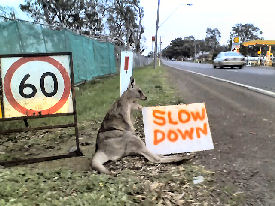 (Photo by Narelle Smith)
(Photo by Narelle Smith)
Predictably, over this period wildlife habitat and populations have been severely impacted. Despite this the Victorian Government and SEITA seem to have failed to seriously consider several other routes, but are persevering in plans to bisect the Mornington Peninsula Biosphere and other crucial habitat for wildlife, according to Gillian Collins of the Pines Flora and Fauna Protection Group and Maryland Wilson of the AWPC.
Their preferred route begins with a major cut through The Pines Flora and Fauna Reserve which provides sanctuary vital to the AWPC and Coalition for Wildife proposed wildife corridor leading to and from the Peninsula Biosphere. For this the Victorian Government, SEITA and Eastlink, have been accused of failing to plan adequately to avoid significant impact on natural habitat and wildlife.
The paradigm of tollways has also been criticised as outmoded and economically unsound because it relies on road-transport and collecting tolls in an economy where many believe that all bets on road-traffic projections should be off because of looming oil and fossil fuel depletion. The motorway will collect tolls using ConnectEast tolling products. www.eastlink.com.au
EastLink decribes itself as "the largest urban road project ever constructed in the State of Victoria with a construction cost of $2.5 billion." It hopes to be "Victoria's second fully-electronic tollway" It will link "the Eastern Freeway in Mitcham with the Frankston Freeway in Melbourne's south-east" in a 39 km motorway.
Eastlink say that they are "one of the largest Public Private Partnerships ever undertaken in Australia." They hope to open on Sunday 29 June 2008.
The Southern and Eastern Integrated Transport Authority (SEITA) was established in 2003 to manage the EastLink Project on behalf of the Victorian Government.
SEITA managed the selection of the private sector bids and now oversees the State's ongoing interest in this landmark Project.
ConnectEast
In October 2004, ConnectEast was awarded the contract to fund, design, build, own and operate EastLink for a period of 39 years. ConnectEast was listed on the Australian Stock Exchange in November 2004.
Thiess John Holland
ConnectEast contracted Thiess John Holland to design and construct EastLink. Thiess John Holland is a joint venture between two of Australia's largest construction and engineering companies - Thiess and John Holland.
An advisory council was also set up with John Nicol, as 'Independent Chair', Janet Holmes à Court, Deputy Chairman; and Frank Corr, Northern Community Representative; Norman Galbraith, Central Community Representative; Geoff Griffiths, Southern Community Representative; Cr Mick Morland, Casey City Council; Mr Tim Tamlin, City of Greater Dandenong; Cr Colin Hampton, Frankston City Council; Mr Ian Bell, Knox City Council; Ms Lydia Wilson, Manningham City Council; * Cr Tony Dib, Maroondah City Council; Cr Craig Shiell, Monash City Council; Cr Tim Rogers, Mornington Peninsula Shire Council; Cr Chris Aubrey, Whitehorse City Council.
John Nicol, the Chair of the advisory council, is a city engineer with Werribee City, and was recently awarded the Order of Australia medal. John Pallas, Minister for Roads and Ports, commended his understanding of 'building a winning image', his ability and character in the following speech, recorded on Victorian Hansard.
Wildlife Campaigner: "SEITA preferred Frankston bypass route will severely impact wildife"

Maryland Wilson, President of the Australian Wildlife Protection Council, stated yesterday that the Southern and Eastern Integrated Transport Authority (SEITA) has failed to adequately address the concerns she raised on behalf of the Australian Wildlife Protection Council or the Coalition of Wildlife Corridors.
Wildlife campaigner says SEITA route for Frankston Bypass will severely impact wildlife
Maryland Wilson, President of the Australian Wildlife Protection Council, stated yesterday (May 14, 2008) that the Southern and Eastern Integrated Transport Authority (SEITA) has failed to adequately address the concerns for wildlife she raised on behalf of the Australian Wildlife Protection Council or the Coalition of Wildlife Corridors. These concerns were specifically about the threat posed to wildlife and their habitat by the infrastructure and traffic which will be created if the SEITA proposed bypass route goes ahead.
Ms Wilson said that the AWPC's observation as well as discussion with persons well-informed in road-engineering, population and land-use planning, Peninsula Biosphere maintenance, wildlife-ecology and social amenity leaves the AWPC in no doubt that
a) the proposed route will severely impact on scarce habitat for local, regional and State biodiversity
b) SEITA and the government have not seriously examined viable alternatives
c) the Pines draft master plan – part two and part three fail to remedy these problems
d) the Pines draft master plan suggestion of a connection between the parts of the Reserve it will split would only present a very insignificant mitigation of the overall drastic damage
e) the proposed restructuring and popularisation of the reserve inaccurately markets new and additional habitat-stress as habitat and wildlife friendly.
"Even worse", said Ms Wilson, "The proposed route will divide the Peninsula in two, making any hope of interconnecting wildlife corridors from East to West of the Peninsula impossible." "Plans for interconnecting corridors have been on the AWPC website now for over a year," she said.
The Wildlife campaigner explained that it is not acceptable for the government or its chosen contractors to go ahead with a structure which, despite some rhetorically supportive policies in Pines draft master plans, parts two and three, is in practice oppositional to international, Australian, and local practice and science for protecting the needs of wildlife.
She added that people needed to be made aware that, "At the moment Frankston and the Peninsula, although part of an international UNESCO agreement for a biosphere that protects fauna and flora, are facing unacceptable decimation of indigenous animals in all or most areas where they struggle to survive."
"Roads, through habitat fragmentation and isolation, through very high rates of road-kill, and through their spear-heading of suburban expansion, are the drivers of animal deaths and species loss."
President Wilson said that SEITA will only encounter and should only encounter opposition if it fails to use alternative routes to protect any indigenous fauna habitat from being cut off from the rest of the Pines, or indeed where similar fragmentation is threatened for any other habitats.
"Australian fauna is at greater risk than at any other time in history due to climate change, drought, habitat-fragmentation and annihilation. The need for more, not fewer, bio-links to save species and individual animals is critical."
"With regards to the other areas of Frankston and the Peninsula, if SEITA continues with the same lack of awareness as previous road-builders in this country, of the many modern methods for mitigating road-kill, such as bridges, tunnels and overpasses, then it cannot expect and will not deserve support."
Her concluding remark demonstrated that the AWPC has a more sophisticated awareness of economy perhaps than do investors in freeways and the governments which support such massive infrastructure projects:
"The population growth and urban expansion which SEITA and similar industry corporations rely on in Australia for customers and investors is not supported by the incumbent population and will probably become very problematical very soon due to oil depletion."
Maryland Wilson, President of the registered charity, Australian Wildlife Protection Council Inc., and spokesman for the Coalition for Wildlife Corridors can be contacted at kangaroo AT peninsula.hotkey.net.au or at 03 59788570, mobile 0417 148 501 The AWPC is located at 247 Flinders Lane Melbourne, Victoria 3000. For further details go to www.awpc.org.au
Australian Wildlife Protection Council submission to the SEITA concerning the Frankston Bypass
To: Ken Mathers, Chief Executive Officer, SEITA, admin [AT] seita.com.au
Cc: Tim Pallas, Minister for Roads and Ports tim.pallas [AT] parliament.vic.gov.au.
Cc: Martin Pakula, martin.pakula [AT] parliamentvic.gov.au
Cc. Joel Benjamin, Biodiversity Vic Roads, joel.benjamin [AT] roads.vic.gov.au
Cc: Bruno Aleksic, Manager Planning, bruno.aleksic [AT] doi.vic.gov.au
May 14, 2008
Dear Mr Mathers,
RE: SEITA - FRANKSTON BYPASS: Seita Ref: DO1072588
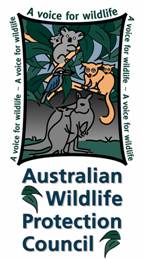 Your response (Seita ref: DO1072588) fails to adequately address the concerns I raised on behalf of the Australian Wildlife Protection Council or the Coalition of Wildlife Corridors. These concerns were specifically about the threat posed to wildlife and their habitat by the infrastructure and traffic which will be created if the SEITA proposed bypass route goes ahead.
Your response (Seita ref: DO1072588) fails to adequately address the concerns I raised on behalf of the Australian Wildlife Protection Council or the Coalition of Wildlife Corridors. These concerns were specifically about the threat posed to wildlife and their habitat by the infrastructure and traffic which will be created if the SEITA proposed bypass route goes ahead.
Our own observation as well as discussion with persons well-informed in road-engineering, population and land-use planning, Peninsula Biosphere maintenance, wildlife-ecology and social amenity leaves us in no doubt that
a) the proposed route will severely impact on scarce habitat for local, regional and State biodiversity
b) SEITA and the government have not seriously examined viable alternatives
c) Pines draft master plan - part two and part three fail to remedy these problems
d) Pines draft master plan suggestion of a connection between the parts of the Reserve it will split would only present a very insignificant mitigation of the overall drastic damage
e) the proposed restructuring and popularisation of the reserves inaccurately markets new and additional habitat-stress as habitat and wildlife friendly
The proposed route will divide the Peninsula in two, making any hope of interconnecting wildlife corridors extremely difficult, if not impossible.
It is not acceptable for the government or its chosen contractors to go ahead with a structure which, despite some rhetorically supportive policies in Pines draft master plans, parts two and three, is in practice oppositional to international, Australian, and local practice and science for protecting the needs of wildlife. At the moment Frankston and the Peninsula, although part of an international UNESCO agreement for a biosphere that protects fauna and flora, are facing unacceptable decimation of indigenous animals in all or most areas where they struggle to survive. Roads, through habitat fragmentation and isolation, through very high rates of road-kill, and through their spear-heading of suburban expansion, are the drivers of animal deaths and species loss.
SEITA will only encounter and should only encounter opposition if it fails to use alternative routes to protect any indigenous fauna habitat from being cut off from the rest of the Pines, or indeed where similar fragmentation is threatened for any other habitats. Australian fauna is at greater risk than at any other time in history due to climate change, drought, habitat-fragmentation and annihilation. The need for more, not fewer, bio-links to save species and individual animals is critical.
With regards to the other areas of Frankston and the Peninsula, if SEITA continues with the same lack of awareness as previous road-builders in this country, of the many modern methods for mitigating road-kill, such as bridges, tunnels and overpasses, then it cannot expect and will not deserve support. This is quite apart from the fact that the population growth and urban expansion which it is relying on in Australia for customers and investors is not supported by the incumbent population and will probably become very problematical very soon due to oil depletion.
Sincerely,
Maryland Wilson, President
Australian Wildlife Protection Council Inc
247 Flinders Lane Melbourne, Victoria 3000
Coalition for Wildlife Corridors
03 59 788 570 ph 03 59 788 302 fax
Mobile 0417 148 501
kangaroo [AT] peninsula.hotkey.net.au
web site: www.awpc.org.au
Registered Charity A0012224D
"As long as people will shed the blood of innocent
creatures there can be no peace, no liberty, no
harmony between people. Slaughter and justice
cannot dwell together."
Nobel Prize Winner ISAAC BASHEVIS SINGER
Residents organise against Frankston Bypass
The following was sent to me by Gillian Collins
A petition against the Bypass has, so far, garnered over 900 signatures and has been presented to Parliament by Jude Perera, our local MP. Another group in South Frankston have 400 signatures on a petition that they have submitted to Southern and Eastern Integrated Transport Authority (SEITA) , and we have submitted documentation that ours have been certified by Parliament, and have asked that they be counted. Since SEITA counted the golf course petition signatures as individual submissions in the Phase One, they cannot do otherwise.
This week we brought some of the issues against the Bypass to the Frankston City Council Major Projects Committee, and I think we got a fair hearing. It looks as though there was no allocation towards it in this year's budget, but we need to look further into that.
One of the results of raising the profile of the anti-Bypass feelings is that the pro-Bypass folk are now starting to campaign. The Chamber of Commerce has a petition that looks remarkably like ours but in favour of it, and they have written to SEITA saying we are "ill-informed!" One of our local Council members is now going to the press with quite unbelievable comments about the Flora and Fauna Reserve being a "wasteland!"
We continue to work on gathering signatures on our petition and generating stories in the press. Next week we are having a community meeting at the school closest to the Reserve to celebrate biodiversity and urge our neighbours to make submissions and contact their elected representatives.
We would appreciate any submissions to the Southern and Eastern Integrated Transpoiort Authority (SEITA) web site: www.seita.com.au. Every one counts, no matter how brief.
For further information: e-mail Gillian Collins at gillianuu [AT] dodo.com.au
See also Australian Wildlife Protection Council submission to the SEITA

Recent comments